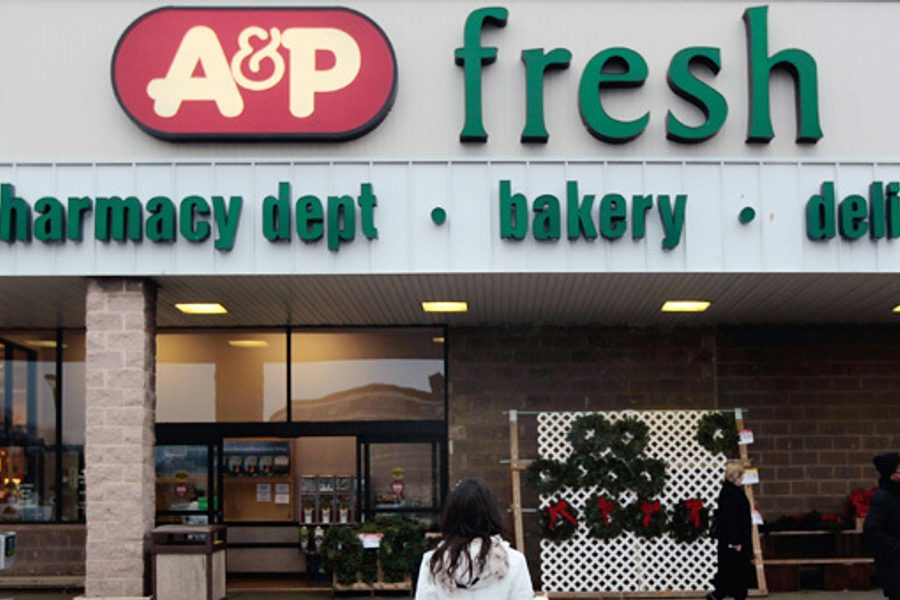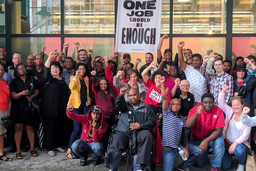
Thousands have been laid-off, while other UFCW members face wage cuts, contract givebacks
A trip through the federal bankruptcy court has been an agonizing experience for some 40,000 union workers at the A&P grocery chain, but a plan for financial renewal is holding out hope that the worst is finally over.
Bankruptcy Judge Robert Drain is inching toward approval of a reorganization plan for the historic food retailer — known officially as the The Great Atlantic & Pacific Tea Co. — after 14 months of store closings, mass firings, tense court proceedings and tortured labor negotiations. Scheduled for final action at the end of February, the renewal plan aims to revive the company’s fortunes under new ownership. But union members took a beating in the process.
Taking the worst of the legal beating were the members of United Food & Commercial Workers union. Spread out across six mid-Atlantic states, about a dozen different UFCW locals represent check-out clerks, butchers, bakers, and other store workers at A&P and subsidiary chains Pathmark, Waldbaum’s, Super Fresh and others. At least 5,000 UFCW members have lost their jobs — some estimates place the total closer to 8,000 — and many more have endured wage cuts and other financial shocks.
“We had to make some adjustments, there’s no question about that,” UFCW National Communications Director Jill Cashen said. It was a bad situation, she said, and local union leaders deserve credit for a “strong collective effort through a very challenging bankruptcy process.”
Cashen was referring, in part, to concessions forced on union members who did not lose their jobs outright. A&P executives demanded union givebacks worth $125 million a year, a number that would be reached through a mix of wage cuts, benefits giveaways and work rule changes spread broadly among the low- and middle-income workers. UFCW formed a negotiating team of leaders from 13 separate locals to deal with the demands.
Hanging over the head of the UFCW team was Section 1113 of U.S. Bankruptcy Code. Under this provision, a judge can okay that collective bargaining agreements to be cancelled outright, inviting the corporate managers to impose whatever working conditions they wish. Without the sweeping givebacks from the union workers, A&P warned, cuts might be worse, or the 153-year-old company would be liquidated altogether.
A&P made things even more anxious for the rank-and-file workers by demanding, and receiving, a strict nondisclosure agreement from the union. The labor leaders were forbidden to discuss the talks with the union members whose livelihoods were at stake. The union members were obliged to work quietly in the dark while their fate was decided by others.
“That hurt. You have members who are worried about their car payments or their mortgages, and I’m not allowed to talk to them about what’s going on? It was cruel,” recalled Pennsylvania UFCW leader Wendell Young.
If A&P was harsh to its cashiers and shelf stockers, it was remorseless to some of its truck drivers and warehouse workers.
In one courthouse maneuver, A&P was able to cancel its contract with a trucking-warehousing company that employed about 900 members of New Jersey Teamsters Local 863. The work was then shifted to cheaper nonunion labor: The jobs of the Local 863 members disappeared overnight.
Something similar happened to the UFCW members working at about 100 grocery stores that have been sold or closed in the last 18 months. The local impacts varied widely – in some cases union members were able to move into similar jobs at other A&P locations, but in others the workers were forced directly onto the unemployment line.
Especially hard hit were grocery workers in Maryland. A&P, as owner of the local Super Fresh chain, put 22 of its stores there up for sale early last year. Some were sold to unionized grocery operators that offered jobs to the displaced workers, but most stores were quickly shuttered. About 1,500 jobs were eliminated, and the workers offered new jobs were generally forced to take cuts.
UFCW’s Young, president of Pennsylvania-based Local 1776, breathed a sigh of relief last week that the bankruptcy case was finally coming to an end. He told In These Times that union members in the greater Philadelphia area suffered in the bankruptcy, but his worst fears had been averted.
“One of their (A&P’s) original demands was the wholesale dumping of the pension plans, but we told them ‘No’ that is something we just couldn’t do,” Young said. Also averted were wholesale wage cuts at Local 1776. Instead, the local offered a plan that trimmed wages for veteran workers, froze future pay increases, and increased health insurance payments, he said. Each of the 13 UFCW locals ended up offering its own individualized package of concessions to reach a total amount acceptable to A&P.
Despite some success in warding off A&P’s most extreme demands, the pain is real. Job losses in Local 1776, for example, fell largely on the teenagers with little seniority and the lowest pay, Young said. And the wage freeze, scheduled to last for an onerous five years, will surely depress the living standards of grocery workers into the future.
“We had our backs against the wall because of the bankruptcy judge,” added Pat Purcell, a top official of New York-based UFCW Local 1500. With nearly 5,000 members employed at A&P stores, Local 1500 was one of the union locals with the most at stake in the continued survival of A&P.
In Local 1500’s case, the members swallowed a 6-percent wage cut, with the promise that the cuts would be restored in the future if the company prospers, Purcell said.
For Ken Jacobs, chairman of the UC Berkeley Labor Center, the A&P story is a familiar saga of retail workers losing earning power in a harsh competitive environment.
“It’s shocking, but not surprising,” that the low-income retail workers take the hardest blows in a bankruptcy like A&P’s, Jacobs said. It’s shocking because the system purposefully punishes the powerless low-income employees, but not surprising because this has become common practice in such cases, he explained.
The federal bankruptcy laws need revision, according to Jacobs, to offer some protection to the vulnerable low-wage workers. Better yet, he said, would be wide adoption of expansive living-wage ordinances that raise pay for all retail workers.







